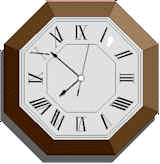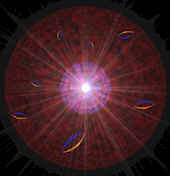The Physical Basis of Time

you can generalize a measurement using a set of properties that you'd like to quantify: |
S = {p0,p1, p2...pn} |
then the general expression for a measurement is: |
M=pi/p0 |
Einstein was once said that "time is what a clock measures". Not very informative -- right? What you'd really want to know is "how does a clock measure time?" Maybe it doesn't! Maybe a clock measures motion!
Well, lets ask: What defines a clock? Think for a minute about how our early ancestors kept time. Their timepieces were the sun, the moon and the stars. No maser clocks, no gears, no back-lit LCD displays and no numbers. Did the stars measure time? No. But our mega-great grand folks could and did use the motion of the sun/moon/stars to tell what "time" it was. Where was the measuring? How would you or anyone else use this astro-clock? Simple! If the sun was straight up then eat lunch. If the sun went behind a mountain -- go to bed. Notice that you don't say "when" the sun is straight up.
Many of our ancestors "motions" were coordinated by the motions of the sun/moon/stars. Some motions were coordinated with respect to the motions of rocks or spears. Why should motion of the sun/moon/stars be special? Short answer: Its just motion but it is a little more consistent than the motion of other objects. Or, you might say that the positions of certain astral bodies are highly coorelated to other important events. Night, day, spring, fall, lunch etc. for example.
Today our clocks (and calendars) represent (are models of) the motions of sun/moon/stars. That's all -- just the motion. We've embellished it a bit by adding the numbers. And at first we kind of screwed it up (see Leap Years).
A clock gives us a reference motion that we can use like we use a ruler (see "The Universe On Its Terms") to measure other motion. For example I can express a measurement of a change in position as v=dx/dt where v is the measured change, dx is the distance traveled and dt is the reference change in position. Yep, v is just velocity. We've just assigned a different name to dt. Remember that our general expression for a measurement of length is = (target)/(reference). Here we are measuring a change in position with a reference change in position.
Of course we can use dt to measure other changes as well. If, for example, you are pouring marbles into a bowl you can use dt as a more general reference in change to express the number of marbles per unit time. This, of course is pretty obvious, but the huge number of uses for clocks makes time a "noisy" subject. There is the arrow of time, the beginning of time, the fourth dimension, time travel, thermodynamics, chaos, strings... Too much! The difficultiy with the subject of time is the focus on the subject of time rather than on clocks. Time misdirects your attention like a magician uses misdirection to distract you from his slight of hand. When the misdirection works you miss the trick and see "magic". In this case the magic is the fourth dimension.
Measuring Velocity
To measure a length we use a static (the static that we like best) object -- a ruler. Take the following example:



 An
artists impression of an electron. Courtesy of
An
artists impression of an electron. Courtesy of